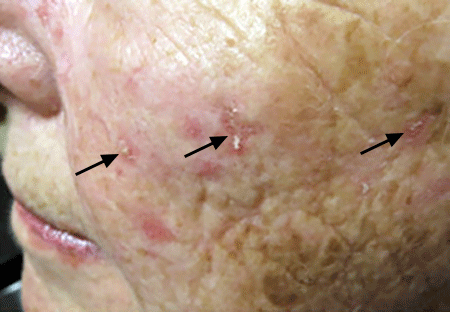5 facts you should know about precancerous skin growths
If your dermatologist tells you that you have a precancerous skin growth, it means one thing. Your skin has been badly damaged by the sun, indoor tanning, or both. The good news is that it’s not too late to do something about this damage and protect your health.
To do this, it helps to understand these 5 facts about precancerous skin growths, which your dermatologist may refer to as actinic keratoses (AKs) or solar keratoses.
Treatment can prevent a precancerous skin growth from progressing to skin cancer. Some precancerous skin growths go on to become a type of skin cancer called squamous cell carcinoma. There’s no way for your dermatologist to know which ones will progress to skin cancer.
Treatment can relieve symptoms, such as itching or tenderness. Some AKs feel tender. An AK can also itch or bleed. When you get rid of the AKs, you get rid of the symptoms.
Some people need multiple and repeat treatments. When you think of treating a precancerous spot on your skin, you probably envision going to your dermatologist’s office for a one-time treatment; however, some people need more involved treatment.
Sun protection delivers big benefits. Many people who have precancerous skin growths are surprised to learn that they need to protect their skin from the sun. They often think that the damage is done, so what’s the point.
Lifelong skin cancer exams can be life-saving. Having just one precancerous skin growth means that the sun, indoor tanning, or both have badly damaged your skin. As such, you have an increased risk of developing skin cancer.
Looks can be deceptive
Precancerous skin growths may look harmless. As you now know, their looks can be deceptive. Following your dermatologist’s recommendations can help protect your skin and your health.
Precancerous skin growths may look harmless
These arrows point to precancerous skin growths that are barely noticeable.

Related AAD resources
Images
Image 2: J Am Acad Dermatol. 2017;76(2):349-50.
References
Tolley K, Argenziano G, et al. “Pharmacoeconomic evaluations in the treatment of actinic keratoses.” Int J Immunopathol Pharmacol. 2017;30(2):178-81.
Uhlenhake EE. “Optimal treatment of actinic keratoses.” Clin Interv Aging. 2013;8:29-35.
Last updated: 7/17/23
 Atopic dermatitis: More FDA-approved treatments
Atopic dermatitis: More FDA-approved treatments
 Biosimilars: 14 FAQs
Biosimilars: 14 FAQs
 How to trim your nails
How to trim your nails
 Relieve uncontrollably itchy skin
Relieve uncontrollably itchy skin
 Fade dark spots
Fade dark spots
 Untreatable razor bumps or acne?
Untreatable razor bumps or acne?
 Tattoo removal
Tattoo removal
 Scar treatment
Scar treatment
 Free materials to help raise skin cancer awareness
Free materials to help raise skin cancer awareness
 Dermatologist-approved lesson plans, activities you can use
Dermatologist-approved lesson plans, activities you can use
 Find a Dermatologist
Find a Dermatologist
 What is a dermatologist?
What is a dermatologist?